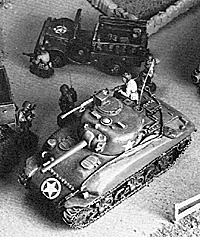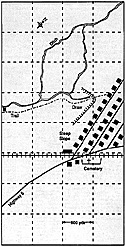At this point US operations shifted from defensive (securing the beachhead)
to offensive. The XIV Corps was to advance as rapidly as possible
south, along the west side of the Central Plains, liberating Clark
Airfield and then on to the Philippines capital city Manila. I Corps,
though lagging behind, would support XIV Corps by covering the XIV's
left flank and rear area from attack by the Japanese Shobu group,
located along the eastern side of the Central Plains.
As the XIV Corps drove south it's units encountered heavy opposition
from the troops of the Kembu group, positioned in the mountains dominating
the approaches to Clark Field. With the XIV Corps's troops committed
against the Japanese in the Zambeles Mountains to the west, their
left flank and rear lay vulnerable to attack from the Japanese in
eastern Luzon.
Opposing the I Corps were the troops of the Shobu group. The Shobu
groups outlying units in the Central Plains were tasked with defending
the approaches to the Groups mountain redoubt. The I Corps had encountered
heavy opposition from the Shobu Groups units and still lagged behind
the forward edge of XIV Corps left flank. In order to cover the XIV's
left flank, as well as deny the Japanese the use of the San Jose railhead,
the 25th Infantry, 6th Infantry, and elements of the newly arrived
1st Cavalry Division were to advance on San Jose, eliminating the
mobile troops of the Shobu group in the process.
The Japanese troops-mainly from the 10th Division and 2nd Tank Division
were to defend the railhead at San Jose as long as possible, then
fall back into the more easily defensible mountain passes to the northeast.
In the face of US air supremacy and a demolished road net, the Japanese broke
up the divisions into defensive strongpoints spaced around the approaches
to San Jose. The strongpoints centered on several small towns and
villages that provided the best defensive terrain in the generally
open countryside of the Central Plains. The main positions were at
Uminagan, and the town of Munoz.
The town of Munoz lay square in the middle of the US 6th Infantry
Division's sector. As part of the general advance, the 20th Regimental
Combat Team (RCT) was tasked with the assault on Munoz. The 6th Infantry's
1st RCT reconnoitered to the southeast of Munoz, while the 63rd RCT
remained in reserve. General Patrick, the 6th Infantry's commander,
wanted Munoz captured as soon as possible and ordered an assault to
take place on the 1st of February.
Day 1 (1 Feb 1945): On February 1st, 1945 the assault began. At
0745 a preliminary barrage consisting of a battalion of 105mm howitzers
and two platoons of 4.2" mortars shelled Munoz for 15 minutes. Following
the barrage the 3rd battalion, 20th RCT, began their approach to Munoz.
The 3/20th's objective was the 2,000 yard stretch of Route 99 running
along western Munoz By 1130 hours the 3/20th's advance had stalled
approximately 500 yards short of Munoz. The attack had faltered in
the face of fierce resistance from Japanese artillery and tank fire.
Following the failure of the 3/20th's attack, the 1 battalion 20th
RCT moves up to the right of the 3/20th. By 1300 hours the battalion
was engaged in a firefight along the south edge of Munoz. By the end
of the day the 1st/20th had advanced no further than the cemetery
running along the south edge of Highway 5.
Day 2 (2 Feb. 1945): The second day of the attack was basically
a repeat of the first day. The 20th made only negligible gains. This
lack of progress infuriated the 6th infantry division's commanding
officer General Patrick. Patrick relieved the 3/20th's commander Colonel
Ives and replaced him with Lt. Colonel Harold G. Maison.
Day 3 (3 Feb. 1945): The 20th now threw everything it had at Munoz.
The regiment's remaining infantry battalion-the second-was brought
up to the left of the 3/20th. The 3/20th and 1/20th continued their
attacks against the west and south sides of Munoz respectively. The
2/20th maneuvered to assault northwestern Munoz. The 3/20th gained
about half a block of western Munoz in bitter street fighting. The
1/20th made no progress against the heavy Japanese opposition. The
2/20th spent the day closing with the Japanese lines and did not
gain a foothold in Munoz by the end of the day.
At the end of the third day of the battle, General Patrick realized
that Munoz was not going to fall to the 20th RCT without further reinforcement.
To that end, Patrick ordered the 6th Infantry Division's other RCT's-the
1st, located to the south of Munoz, and the 63rd RCT, the division
reserve - to bypass the strongpoint at Munoz and press on to San Jose,
then support the attack on Munoz. San Jose fell virtually undefended
on the morning of 4 February 1945. At Munoz, the 20th RCT's continued
attacks made no progress was made from the 4th through the 6th.
The 6th Division planned for an all out assault on Munoz on February
7th. However, the Japanese troops refused to cooperate with the US
plans. In the early morning hours of the 7th, the surviving Japanese
garrison withdrew up Highway 5 toward San Jose-not realizing it seems
that San Jose was now in United States hands. Attempting to smash
through the roadblocks of the 63rd RCT, 53rd and 80th field artillery as well as the 2/161 RCT.
The Japanese were annihilated.
While on the surface the battle of Munoz appears to be a crushing
American Victory, the Japanese had met their goals. Certainly, the
2nd Tank Division, having lost all its tanks ceased being an offensive
threat to the 6th Army's drive on Manila. But, San Jose had been held
long enough for the 105th Division as well as all the supplies available
to move in the formidable the Cordilla Central and the Sierra Madres
mountains. It was this successful delaying operation that enabled
the Japanese to hold out in Northern Luzon, longer than anywhere else
in Luzon.
Large Map (75K)
The town of Munoz consists of five intact wooden buildings,
one stone building, and a large quantity of burnt out wooden buildings
and rubble. Burnt out buildings provide cover for troops within them.
Set up: The Japanese players set up first, followed by the United
States players. It is strongly encouraged that the Japanese be allowed
to use hidden initial placement of their stands, or, failing that,
that the Japanese use counters and dummy markers to indicate the location
of their stands. The US stands are placed on the playing surface,
even if not spotted by the Japanese.
Japanese Setup: The Japanese stands are deployed anywhere within
and area bounded by a line running 2 inches outside of the edge of
Munoz. The 105mm howitzers are deployed anywhere within Munoz. Tanks
start the game in tank ramps and may not move. Treat the tanks as
hull down from any aspect. All infantry stands are considered to be
entrenched, all MMG stands and anti-tank guns are considered in bunkers.
Artillery is placed in weapons pits.
United States setup: Unites States stands deploy within 8 inches
of the southwest map edge. The 2/20th RCT in the north, the 3/20th
in the center and the 1/20th in the south. All artillery, except mortars
(both 81mm and 4.2") is deployed off board. The 81mm and 4.2" mortars
may be deployed anywhere within 4" of the US baseline on the southwest
edge of the playing area. Forward observer stands start the game on
the playing surface deployed according to the US players desires.
1. Offensive Map Fire: The US conducts a pre-assault artillery barrage
by two battalions of 105mm howitzers on the turn immediately before
the scenario begins. These units are not included in the order of
battle and may not be used for the duration of the scenario. The barrage
may be placed anywhere the US player desires. The referee will resolve
the barrage and the morale check on effected Japanese units. Following
this begin the scenario with the 0800 hours turn.
2. Air Support: Historically air support played a minor role in
the assault on Munoz. However, the possibility of air support does
exist. At the start of each hour (for example-0800, 0900, etc.) roll
one D10 and consult the following table;
All aircraft operate under a general support order. The turn of entry,
altitude at entry, target of the attack, and bomb pattern, must all
be declared at this time.
3. Scenario Length and Environment: The game begins with the 0800
hours 1 February 1945 turn and lasts until the 1800 hours 1 February
turn. Due to the small amount of mobile armor present for the battle,
the time scale has been change to 1 turn represents 30 minutes, giving
a total of 22 game turns for the scenario.
4. Victory Conditions: To win a decisive victory the US must capture
the town of Munoz by the end of the 1730 hours turn while suffering
no more than 20 stands of casualties (all types). If the US suffers
more than 20 stands losses and captures the town, they receive a minor
victory. If the US lose more than 30 stands (all types) and capture
the town it is a draw.
If the US forces fail to take the town, the Japanese receive a minor victory. If the Japanese can eliminate more than 15 stands, and hold the town they receive a major victory. If
they eliminate over 30 stands and hold the town, the Japanese achieve a decisive victory.
Related
 On January 9th, 1945, United States troops landed at
Lingayen Gulf on the north shore of Luzon in the Philippines. The
6th US Army-consisting of XIV and I Corps-landed four infantry divisions,
as well as supporting troops and construction units. Encountering
weak opposition from the Japanese 23rd Division and 58th Mixed Brigade,
the US troops pushed south enlarging the beachhead and by January
16th had secured the 6th Army's base for supply and reinforcement
of further offensives.
On January 9th, 1945, United States troops landed at
Lingayen Gulf on the north shore of Luzon in the Philippines. The
6th US Army-consisting of XIV and I Corps-landed four infantry divisions,
as well as supporting troops and construction units. Encountering
weak opposition from the Japanese 23rd Division and 58th Mixed Brigade,
the US troops pushed south enlarging the beachhead and by January
16th had secured the 6th Army's base for supply and reinforcement
of further offensives.
CAMPAIGN SYNOPSIS
AFTERMATH
GAMING THE BATTLE FOR MUNOZ
 Terrain: The ground surrounding Munoz is a flat, open plain providing
little cover. The only noteworthy terrain features consist of a network
of irrigation ditches to the west of Munoz, and a shallow draw, centered
on the western side of the town and opening to the west. One main
road-Highway 5 - crosses the playing area and runs along the southeast
edge of Munoz.
Terrain: The ground surrounding Munoz is a flat, open plain providing
little cover. The only noteworthy terrain features consist of a network
of irrigation ditches to the west of Munoz, and a shallow draw, centered
on the western side of the town and opening to the west. One main
road-Highway 5 - crosses the playing area and runs along the southeast
edge of Munoz.
Jumbo Map (221K)
REFEREE'S NOTES
1-6: no air support received
7: 1 B-25
8: 1 P-40
9: 1 P-38 Lightning
10: 1 F4U Corsair
Back to Table of Contents -- Courier #67
To Courier List of Issues
To MagWeb Master Magazine List
© Copyright 1995 by The Courier Publishing Company.
This article appears in MagWeb (Magazine Web) on the Internet World Wide Web.
Other military history articles and gaming articles are available at http://www.magweb.com